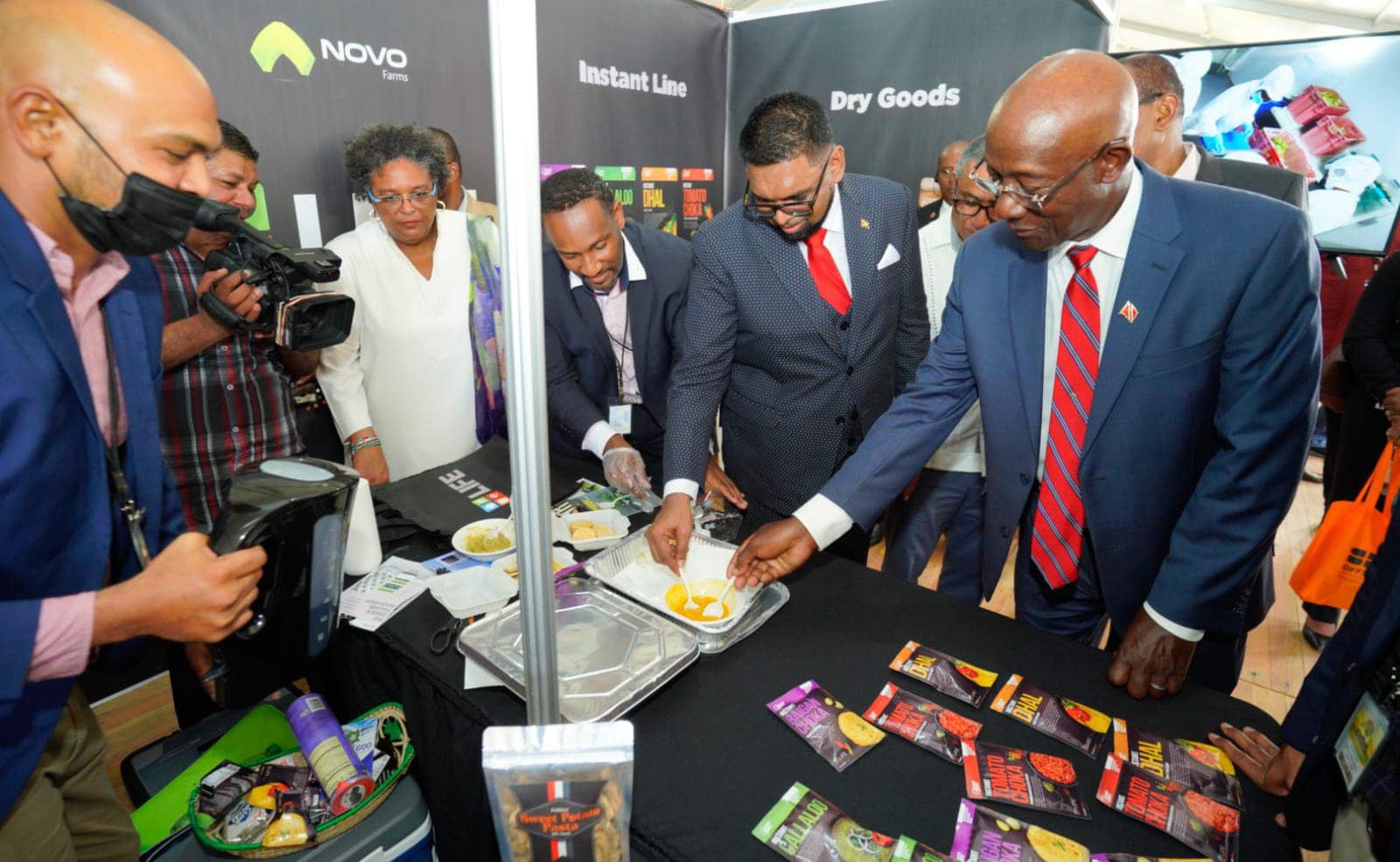During the period August 19-21, 2022, the Trinidad and Tobago (T&T) Government hosted the Agri Investment Forum and Expo II (AIFEII): Transforming Agriculture through Innovation and Investment. It followed one held in May in Guyana. All CARICOM States, including nine Heads, were represented, in addition to the CARICOM Secretary General (SG), representatives of the Caricom Private Sector Organisation (CPSO), plus other high-ranking officials.

For decades, agriculture and food had not experienced such unanimous support from Heads with their presence at two major meetings. The June 2022 Summit of the Americas also emphasised this importance, when food security, energy security and development/debt finance were prioritised by Caribbean and USA leaders.
|
“Oil and gas revenues from Guyana, Suriname and Trinidad and Tobago are critical to directly enhancing regional food security.” |
Even though there were some significant conclusions as detailed below in the takeaways, it was obvious that oil and gas revenues from Guyana, Suriname and Trinidad and Tobago are critical to directly enhancing regional food security. These revenues will also indirectly minimise the economic stagnation in “non-oil countries” with possible intra-regional human migration with concomitant national social and security challenges. CARICOM’s sister states need each other.
The specific takeaways are first, improving regional food security remains uppermost. Residual negative pandemic impacts, climate change and the Russia/Ukraine war – with their consequences – dictate urgent, intensive, and coordinated actions.
Second, commodities were prioritised towards achieving the target “25×2025” – the reduction of regional imports by 25% by the year 2025. The entire value chain (VC) was emphasised along with intra-regional supply sources requiring current food importers to “get on board” thus validating the slogan “grow what we eat, eat what we grow”.
Third, the regional private sector was intimately involved. The CPSO signed (i) three MOUs: with the Caribbean Manufacturers Association and the Caribbean Supermarkets Association, to enhance representation along the VC, and the Caribbean Agribusiness Association (CABA) to recognise the traditional importance of Micro, Small and Medium-sized Enterprises (MSMEs) as major regional food producers, and (ii) a Declaration with the Governments reinforcing their commitment to the long-term nature of this initiative.
Fourth, inadequate intra-regional air and sea transport, including unsuitable port infrastructure, and Non-Tariff Barriers, including differentiated interpretation of guidelines, remain major impediments to intra-regional trade and strong investments in infrastructure are needed.
Fifth, there has been critical “work in progress”. For example, the completion of four policy instruments, including the “Regional Agricultural Health and Food Safety Policy” and “Alternate Sanitary and Phytosanitary Dispute Resolution Mechanism”. Similarly, (i) CARICOM and Guyana had submitted seven projects for funding with others coming from St. Lucia, St. Vincent and the Grenadines and T&T, (ii) US$29 million received from United States Agency for International Development (USAID), and (iii) an “Implementation and Monitoring Unit” was being established. Further, Guyana and T&T had established a joint Technical Task Force, and Suriname was making land available for production.
Finally, tangible progress was slower than anticipated as exemplified by (i) “now is time to act out what we continuously spoke to”, (ii) exhortation for the Universities of Guyana, T&T and the West Indies to be involved, (iii) notification to the regional private sector to quickly address intraregional transport or attention may be turned extra regionally, (iv) all appropriate national ministries have been “written to”, and (v) when the 25×2025 target was set in 2018, climate change was the only major threat but now there are additionally the COVID-19 pandemic and the Russia-Ukraine war.
|
“The regional public is aware of the possibilities of growing food insecurity, but because of previous failures, there’s cautious optimism for the success of the 25×2025 initiative.” |
In summary, unanimous and enthusiastic political will prevails, but with implicit unease at the perceived slow state of tangible progress. The regional public is aware of the possibilities of growing food insecurity, but because of previous failures, there’s cautious optimism for the success of the 25×2025 initiative.
Member states have identified development/debt finance as critical to their sustainable development. However, the implication is that there is minimal fiscal space to borrow to implement the needed institutional and physical requirements. Grant funds are needed for the 25×2025 initiative to be successful, and to reduce possible catastrophic consequences to agriculture and its many linked sectors in all of CARICOM.
As posited in previous articles, these revenues should come from both governments and companies, financing “hard” and “soft” activities, respectively. Whilst some companies have recently identified support for agricultural activities, these need to be within a total regional/national regime.
The above suggestions remain relevant to address the following (institutional, national, and promotional) shortcomings to enable a tangible way forward post AIFEII that will satisfy all stakeholders.
The Institution is the pillar that glues the other (social, economic, and environmental) pillars to achieve sustainable development. Institutions within and without the sector facilitate continuity. Unfortunately, national and regional agriculture and food production institutions have not been fully supported. For example, depending on the source, the regional annual food import bill reportedly ranges from US$4-6 billion. There’s no source of reliable data readily available and this is historical, not “real-time online” data. The latter form is needed by the private sector to make either ongoing business and/or capital investment decisions. The CARICOM Commission on the Economy, October 2020, recommended digital transformation. This should include a regional agricultural trade/information system linked to national nodes.
|
“It is reported that annual budgets for national agricultural Ministries have reduced – at least percentage-wise of total national budgets – over the last decade. Similarly, subventions of regional agricultural institutions have not matched inflation.” |
Further, it is reported that annual budgets for national agricultural Ministries have reduced – at least percentage-wise of total national budgets – over the last decade. Similarly, subventions of regional agricultural institutions have not matched inflation. The result is inadequate human, technical and physical capital for normal activity. The current initiative requires accelerated and expanded programmes including, for example, the manufacture and use of rice flour replacing quantities of wheat flour. To bolster the limited capacity of these institutions, it is recommended that they partner/twin with relevant entities in the Americas.
Additionally, national Ministries can make use of facilities, as offered by the Unilateral Trust Fund of the Food and Agriculture Organisation of the United Nations, to obtain in-house experts providing on-the-job training in the preparation of appropriate documents. This enhanced capacity (a) would complement the announced regional implementation and monitoring unit and (b) should enable timely responses.
These “soft” activities could be funded, within an agreed, focused, scheduled and results-driven programme, by the oil and gas companies. This should be seen as part of wider Corporate Social Responsibility (CSR) contributions to sustainable economic diversification throughout the region. It isn’t budgetary support and, if tho0ught desirable, could be administered by either the CARICOM Secretariat or Caribbean Development Bank.
With respect to the nation, greater public linkage is needed between programmes, such as vegetable seedling distribution, and the 25×2025 initiative. Such visible relationships could be championed, not implemented, by Governments, between micro, small and medium enterprises (MSMEs) (possibly Caribbean Agri-Business Association members) and large companies (possibly CARICOM Private Sector Organisation members) within selected value chains. One such programme that could be emulated is fruit and vegetable cultivation in pilot Jamaican communities, led by Caribbean Broilers which provides technical, processing and market support.
Administratively, the national programme with agreed-upon finances must be conceptualised, detailed, scheduled, monitored, and evaluated by an all-embracing public/private sector committee chaired by a representative of the Head.
Further, visible evidence is needed that long-standing issues critical to the sustainability of individual enterprises, are being addressed. These include land tenure, farm-to-market roads, modern rural markets with packhouses, supply of inputs, and control of praedial larceny. These require significant financial resources. Based on the implicit inability of most CARICOM countries to incur further debt, a 25×2025 Food Security Grant Fund, as provided by the three oil and gas countries, is recommended.
Regular and effective promotion is required to “bring on board” the “man in the street” who must accept the initiative, has final responsibility for its successful implementation, and must accept necessary dietary changes. Performance reports must be ongoing. It cannot be disseminated only at “big events”.
|
“Oil and gas revenues are key contributors to achieving meaningful follow-up to AIFEII for the successful implementation of the 25×2025 initiative. This would enable all member states to minimise the uncertainty of food supply, growth of food insecurity, and possible social unrest.” |
The information must be complete. For example, an explanation of (i) the elements of the policy documents developed and how they will facilitate trade and/or ease of doing business, and (ii) what is the nature of the projects submitted for financing and the anticipated terms and conditions.
Oil and gas revenues are key contributors to achieving meaningful follow-up to AIFEII for the successful implementation of the 25×2025 initiative. This would enable all member states to minimise the uncertainty of food supply, growth of food insecurity, and possible social unrest.
Note: This article was first published in https://oilnow.gy/featured/agri-investment-forum-and-expo-ii-and-role-of-oil-and-gas-revenues/
Note: The opinions expressed in this article are the responsibility of the author and do not necessarily reflect the opinion of IICA.
 Dr H Arlington D Chesney is a leading Caribbean Agricultural professional who has served his country, the Caribbean and the hemisphere. He is a Professional Emeritus of the Inter-American Institute for Cooperation on Agriculture and, in 2011, was awarded Guyana’s Golden Arrow of Achievement for his contribution to agricultural development in Guyana and the Caribbean.
Dr H Arlington D Chesney is a leading Caribbean Agricultural professional who has served his country, the Caribbean and the hemisphere. He is a Professional Emeritus of the Inter-American Institute for Cooperation on Agriculture and, in 2011, was awarded Guyana’s Golden Arrow of Achievement for his contribution to agricultural development in Guyana and the Caribbean.
|
If you have questions or suggestions for improving the BlogIICA, please write to the editors: Joaquín Arias and Viviana Palmieri. |
Añadir nuevo comentario